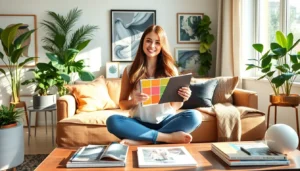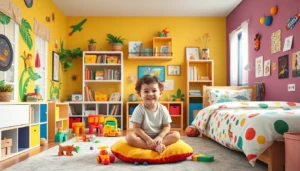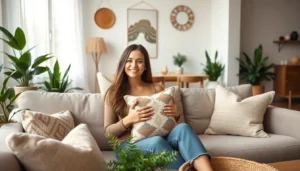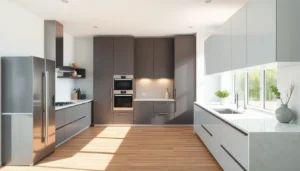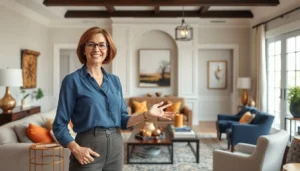Table of Contents
ToggleIn a world where beige walls and mismatched furniture reign supreme, interior design blogs are the stylish superheroes we didn’t know we needed. They swoop in with fresh ideas, transforming drab spaces into dazzling havens. Whether it’s a cozy nook or a grand living room, these blogs have the power to ignite creativity and inspire anyone to unleash their inner designer.
Overview of Interior Design Blogs
Interior design blogs serve as essential platforms for sharing design ideas and trends. They offer a wide range of content, from DIY projects to expert advice, catering to various tastes and preferences. Readers find valuable tips that help them enhance their own spaces, creating environments that reflect their unique styles.
Designers and enthusiasts contribute regular posts, showcasing innovative concepts and practical solutions. Many blogs also incorporate visual elements, such as images and videos, to illustrate design techniques or before-and-after transformations. This visual content helps readers envision the potential of their spaces.
Market research indicates that over 50% of individuals rely on blogs for home improvement inspiration. Blogging has become a vital source of information for those seeking guidance on color palettes, furniture choices, and layout planning.
Communities form around these blogs, allowing readers to share experiences and ideas. Interaction occurs through comments and social media, fostering connections among like-minded individuals. A strong sense of belonging develops, encouraging readers to explore their creativity further.
Reputable interior design blogs often feature interviews with industry experts, providing insights into current trends and future predictions. This access to expert opinions helps readers stay informed about the evolving landscape of interior design.
Overall, interior design blogs represent a dynamic fusion of information and creativity, empowering individuals to transform their homes into personalized retreats.
Popular Interior Design Blogs

Numerous interior design blogs serve as vital sources of inspiration and creativity. They showcase various styles and innovations, offering readers fresh ideas for their spaces.
Blog 1: Features and Style
This blog features clean lines and a minimalist aesthetic. Readers appreciate the focus on neutral color palettes and natural materials. Each post includes high-quality images that demonstrate practical applications of design concepts. Designers often share tips on balancing functionality with style, helping readers create harmonious environments. Regular updates provide insights into emerging trends, keeping content fresh and relevant. Engaging dialogue in the comments section fosters community, encouraging readers to share their own interpretations and adaptations.
Blog 2: Unique Approach
This blog takes an unconventional approach to interior design. It celebrates bold colors and eclectic styles, moving beyond typical design themes. Each article presents innovative DIY projects that readers can easily replicate. The emphasis lies on sustainability, promoting upcycled materials and eco-friendly choices. Visual storytelling enhances the user experience, allowing readers to visualize potential transformations. Expert interviews provide added depth, spotlighting diverse perspectives within the industry. This blend of creativity and practical advice makes the blog a favorite among design enthusiasts.
Key Elements of a Successful Interior Design Blog
Successful interior design blogs combine various elements that enhance reader experience and foster engagement. Content resonates most when it’s practical, inspiring, and visually captivating, inviting readers to explore new ideas.
Engaging Content
Engaging content captivates audiences through practical tips and relatable stories. Posts should cover diverse topics, such as DIY projects, decorating hacks, and organizational strategies. Readers appreciate real-life examples that highlight design techniques, as these offer clear inspiration. Incorporating personal anecdotes and case studies creates a sense of connection, encouraging readers to interact with the material. Inclusive language fosters community by allowing various voices to be heard, making the blog approachable and accessible.
Visual Appeal
Visual appeal greatly influences how content is received. High-quality images illustrate design concepts effectively, showcasing colors, textures, and layouts that resonate with audiences. Formatting that emphasizes visuals, such as galleries or slideshows, keeps readers engaged and encourages exploration. Videos demonstrating design processes bring concepts to life, allowing for better understanding. A visually cohesive aesthetic not only reflects the blog’s style but also invites readers to linger, ultimately enhancing the overall experience.
Trends in Interior Design Blogging
Emerging trends in interior design blogging reflect evolving consumer interests and preferences. Minimalism gains traction with readers favoring clean lines and uncluttered spaces. Sustainable design also becomes a focal point, as bloggers incorporate eco-friendly materials and practices.
In addition, blogs increasingly embrace technology. Augmented reality tools allow users to visualize design changes in their own spaces before committing. Interactive content enhances engagement, offering quizzes and polls that help users determine their design style.
Bold colors and maximalism make a comeback in several popular blogs. Designers showcase vibrant palettes combined with unique patterns. This trend resonates with readers looking to infuse personality into their homes, encouraging creativity in decor choices.
Video content flourishes in design blogs. Bloggers post tutorials demonstrating various design techniques, enhancing understanding of concepts. Visual storytelling creates an immersive experience, allowing readers to relate directly to each project.
Communities around interior design blogging continue to expand. Comment sections become vibrant forums for discussion, where readers share ideas and inspiration. Online workshops hosted by experienced designers attract large audiences, providing valuable, real-time learning opportunities.
Diversity in design styles finds representation in blogs. Themes range from bohemian chic to contemporary urban, appealing to a wide audience. Varied content caters to different tastes, ensuring all readers find inspiration that resonates with their personal style.
Increased collaboration among bloggers and brands enhances content quality. Sponsored posts featuring product reviews or design collaborations provide readers with trusted recommendations. This partnership not only benefits bloggers but also offers brands a platform to reach interested audiences.
Interior design blogs serve as invaluable resources for anyone looking to elevate their living spaces. They inspire creativity and foster a sense of community among design enthusiasts. By providing practical tips and showcasing diverse styles, these blogs empower readers to embark on their own design journeys.
The integration of technology and emerging trends keeps the content fresh and engaging. As more individuals seek inspiration online, the role of these blogs will continue to grow. They not only guide readers in making informed choices but also encourage a deeper connection to their personal style. Embracing the insights from these platforms can lead to beautifully transformed spaces that truly reflect individual tastes.

